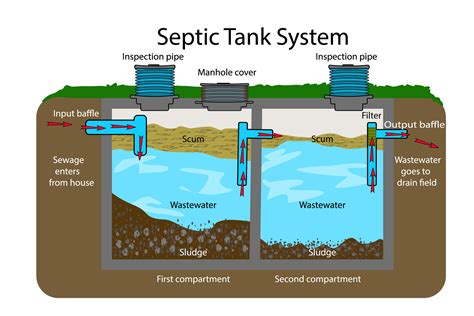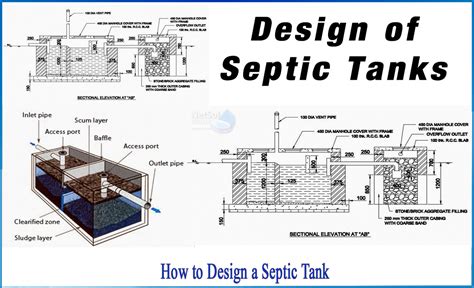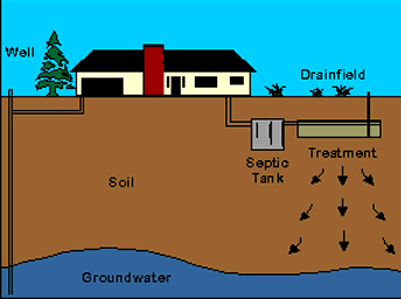Septic Tank Design

Septic tank design is a crucial aspect of wastewater management, particularly in areas where access to centralized sewer systems is limited. A well-designed septic tank can effectively treat and dispose of domestic wastewater, protecting public health and the environment. In this article, we will delve into the key components and considerations of septic tank design, highlighting the importance of proper planning, construction, and maintenance.
Introduction to Septic Tank Design

A septic tank is a watertight container that uses natural processes to break down organic matter and separate liquids from solids. The design of a septic tank involves a thorough understanding of wastewater characteristics, soil conditions, and local regulations. The primary goal of septic tank design is to create a system that can efficiently treat wastewater, preventing pollution and ensuring a safe environment for humans and wildlife.
Key Components of Septic Tank Design
A typical septic tank consists of several key components, including:
- Inlet and outlet pipes: These pipes connect the septic tank to the house and the drainfield, respectively.
- Tank body: The tank body is the main container where wastewater is stored and treated.
- Baffles: Baffles are walls or partitions that separate the tank into different compartments, allowing for the separation of liquids and solids.
- Drainfield: The drainfield, also known as the leach field, is the area where treated wastewater is discharged into the soil.
The design of these components is critical to the overall performance of the septic tank. For example, the size and shape of the tank body must be sufficient to hold the required volume of wastewater, while the baffle configuration must allow for effective separation of liquids and solids.
| Component | Description |
|---|---|
| Inlet Pipe | Connects the house to the septic tank |
| Outlet Pipe | Connects the septic tank to the drainfield |
| Tank Body | Main container for wastewater treatment |
| Baffles | Separate liquids from solids |
| Drainfield | Area where treated wastewater is discharged |

Factors Influencing Septic Tank Design

Several factors must be considered when designing a septic tank, including:
- Wastewater characteristics: The type and amount of wastewater generated by the household or business must be taken into account.
- Soil conditions: The type and permeability of the soil affect the design of the drainfield and the overall performance of the septic tank.
- Local regulations: Septic tank design must comply with local regulations and guidelines, which may vary depending on the jurisdiction.
- Climate and topography: The climate and topography of the area can impact the performance of the septic tank, particularly in areas with high water tables or extreme weather conditions.
These factors must be carefully evaluated to ensure that the septic tank is designed and constructed to meet the specific needs of the site and the users.
Design Considerations for Septic Tank Construction
The construction of a septic tank requires careful consideration of several design factors, including:
- Tank size and shape: The size and shape of the tank must be sufficient to hold the required volume of wastewater.
- Material selection: The materials used for the tank body, inlet and outlet pipes, and other components must be durable and resistant to corrosion.
- Baffle configuration: The baffle configuration must allow for effective separation of liquids and solids.
- Drainfield design: The design of the drainfield must take into account the soil conditions, wastewater characteristics, and local regulations.
A well-designed septic tank can provide effective treatment and disposal of wastewater, protecting public health and the environment. However, improper design and construction can lead to system failure, resulting in costly repairs and potential environmental damage.
Performance Analysis of Septic Tank Design
The performance of a septic tank is critical to its effectiveness in treating and disposing of wastewater. Several factors can impact the performance of a septic tank, including:
- Wastewater characteristics: The type and amount of wastewater generated by the household or business can affect the performance of the septic tank.
- Soil conditions: The type and permeability of the soil can impact the performance of the drainfield and the overall effectiveness of the septic tank.
- System maintenance: Regular maintenance and inspections are essential to ensuring the longevity and effectiveness of the septic tank.
A well-designed septic tank can provide effective treatment and disposal of wastewater, protecting public health and the environment. However, improper design and construction can lead to system failure, resulting in costly repairs and potential environmental damage.
| Factor | Impact on Performance |
|---|---|
| Wastewater Characteristics | Affects treatment efficiency and system longevity |
| Soil Conditions | Affects drainfield performance and system effectiveness |
| System Maintenance | Affects system longevity and effectiveness |
What are the key components of a septic tank?
+
The key components of a septic tank include the inlet and outlet pipes, tank body, baffles, and drainfield.
What factors influence septic tank design?
+
Several factors influence septic tank design, including wastewater characteristics, soil conditions, local regulations, climate, and topography.
Why is regular maintenance important for septic tanks?
+
Regular maintenance is essential to ensuring the longevity and effectiveness of the septic tank, preventing system failure and potential environmental damage.
What can happen if a septic tank is not designed or constructed properly?
+
Improper design and construction can lead to system failure, resulting in costly repairs and potential environmental damage.
How often should a septic tank be inspected and maintained?
+
Regular inspections and maintenance should be performed at least every 3-5 years, or as recommended by local regulations and industry guidelines.


